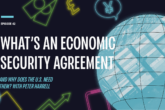April 11, 2022
Russia’s Economy Has Adjusted to Sanctions. That Doesn’t Mean Moscow Is Winning the Financial War.
There have been signs over the past several days that Russia’s economy is adapting to the harsh economic sanctions imposed on it in response to the invasion of Ukraine. The ruble has rebounded. The extreme stress on the domestic banking sector has moderated. The Russian government continues to make debt payments and sell most of its oil. And on Friday, the central bank cut its benchmark interest rate, after having doubled it in the immediate wake of the sanctions.
All this activity is partly a reflection of the technocratic skill of the officials in charge of Russian economic policy, the persistence of energy revenues (Russia’s most important revenue source), and a kind of broad adaptation to sanctions that other states in comparable situations have experienced, admittedly at a cost to economic well-being. What these adjustments are not, however, are obvious signs that the U.S. and its allies are losing the economic war against Russia. At least not yet. Rather, they are a reminder that the effort to impose economic costs on Russia is a long game aimed to degrade its capacity to continue the conflict and its future prospects.
It is far too soon to declare defeat, just as it was far too soon to declare with pride that the ruble was “reduced to rubble,” as President Biden said a few weeks ago.
Doing so raised expectations that economic stress would prompt immediate collapse. But these economic restrictions were never supposed to single-handedly force Russia to abandon its military plans—though many of us hoped they would as Russia faced the choice of wrecking its economy and future prospects. Both on and off the battlefield, Russian policy makers have not exactly followed traditional cost-benefit analysis. Moscow’s distorted decision making, combined with the lack of easy, cheap, asymmetric policies that the coalition can use to influence Russia, means that these measures need time to build. Sanctioned targets retain some policy agency. Likewise, the U.S. and allies will need to calibrate the pressure they are bringing to bear and focus more on how to cushion the blow for global consumers.
Read the full article from Barron's.
More from CNAS
-
Economic Security in North America
Executive Summary In its request for comment, the Office of the U.S. Trade Representative (USTR) solicits comments on and recommendations for “specific actions [to promote] al...
By Emily Kilcrease & Geoffrey Gertz
-
How Sanctions Became a Way to Wage War and When They Actually Work, with Eddie Fishman
In this episode of “Financial Crime Matters,“ Kieran Beer talks with Eddie Fishman, CNAS adjunct senior fellow and author of “Chokepoints: How the Global Economy Became a Weap...
By Edward Fishman
-
Defense / Energy, Economics & Security / Technology & National Security
The Outlook CEO Perspectives on Risk, Resilience and ReturnsJoin David Schwimmer and Richard Fontaine, CEO of the Center for New American Security, as they explore the current national security landscape and its impacts on global econo...
By Richard Fontaine
-
What's an Economic Security Agreement and Why Does the U.S. Need Them? With Peter Harrell
Derisky Business is returning for season 2! After a brief hiatus in which obviously nothing (nothing!) notable happened in the world of trade and economic security, Emily and ...
By Geoffrey Gertz & Emily Kilcrease




